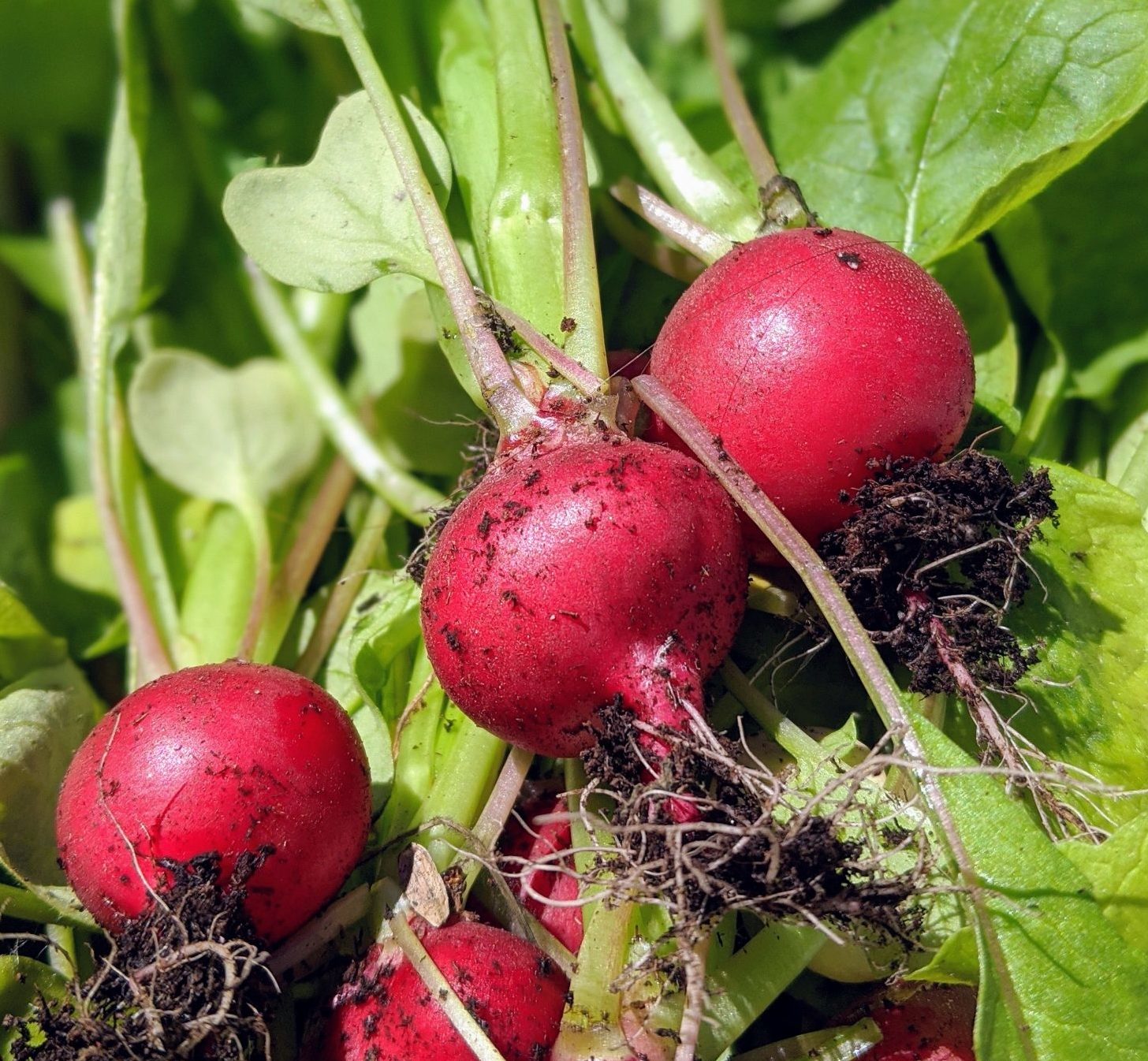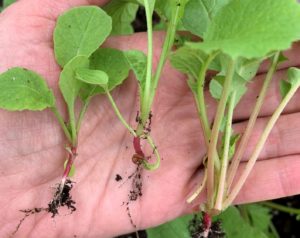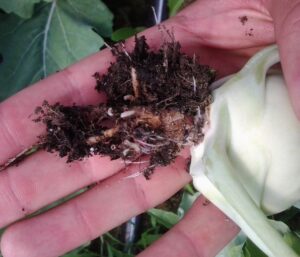Radishes are globed-shaped root vegetables that are members of the brassica family, which includes broccoli, cauliflower, Brussels sprouts, cabbage, and kale. Depending on the variety, radishes can be red, pink, white, purple, and even black! They pack a peppery flavor and are a source of vitamin C, iron, potassium, folate, vitamin B6, manganese, and fiber. They are one of the easiest vegetables to grow and are perfect for first-time gardeners and kids! They take up little space compared to other crops and are ready to harvest in as little as three weeks.
Soil, Sun, and Water
Like other root vegetables, radishes require soil that is loose and well-draining. If the soil is too dense, the bulbous root will struggle to develop, and if the soil doesn’t drain well, the radish could end up with root rot. Soil that is too high in nitrogen can also be detrimental for root crops because the nutrient will cause the plant to develop its leaves instead of the root. (If you want to learn more, here’s my article on the 5 Reasons Why Radishes Don’t Develop.) The key then is to plant the seeds in healthy, balanced soil that has a pH level between 6.0 an 7.0.
Radishes need at least six hours of full sun. If they don’t receive enough sunlight, the plants will direct their energy into growing bigger leaves in order to capture more light. Bigger leaves mean smaller radishes.
All varieties of radishes need to be watered consistently. Do not allow the plants to dry out, or it will negatively affect their flavor, and they will be more likely to bolt. On the other hand, too much water can cause the radish to split and rot. Again, balance is the key.
How and When to Plant Radishes Seeds
Radishes are cool weather crops, meaning they need to be planted in the early spring or fall and grow best in temperatures that are 75 F or below. If you plant them in warmer weather, it will cause them to be spicier, but you will run the risk of the plant bolting and turning woody and thus inedible.
Root disturbance can cause carrots, radishes, and other root crops to have deformed roots. Thus, it is better to direct sow the seeds and not transplant them. For a spring crop, direct sow the seeds between four and six weeks before the last frost date, when the soil is 40 F or above. For a fall crop, direct sow seeds about four to six weeks before the first fall frost date. If you don’t know when your area’s frost dates are, you can find the link on my Resource Page under “Helpful Garden Links” section.
Ultimately, you’ll want to consult the instructions on the seed packet, but generally speaking, radish seeds are sown about 1/2 inch deep in the soil. Each seed will need room to grow into a well-formed radish, so space the seeds about two inches apart. Certain varieties like Daikon radishes require spacing that is 3 inches to 4 inches apart. The seeds will germinate in three to ten days. Once the seedlings are 2 inches tall, thin them out if needed, being sure to cut the less desirable seedling off at the soil level. Do not pull the seedling as it could disturb the root of the one next to it. You can use the thinned out seedlings as microgreens, so there is no waste!
Radishes are perfect for succession planting. Plant an additional round of seeds every 10 to 14 days. Continue this cycle as long as the weather permits.
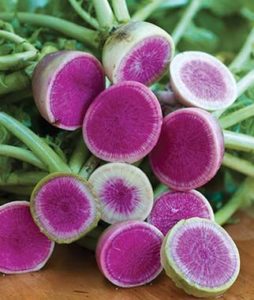
Container Radishes
Radishes are great for growing in containers. You’ll need a container that is food-safe and at least six inches deep. If you’re growing Daikon radishes, however, they require a container that is 12 to 14 inches deep because they have a longer root. As for the diameter of the container, you can grow as many as 6 to 8 plants in one that is 12 inches wide, but a narrow container, like a window box, will work just as well. Regardless of the shape of the container, make sure you space the seeds appropriately.
This article contains affiliate links. If you make a purchase using one of these links, I will receive a very small commission at no additional cost to you, and it will help me maintain this website. Rest assured that I only recommend products I actually like!
To Fertilize or Not to Fertilize
Fertilizing radishes is one area where the experts offer differing opinions. As mentioned earlier, too much fertilizer, especially one high in nitrogen, can stunt radish growth by causing the plant to pour all of its energy into growing leaves instead of the bulb. Therefore, some advocate not fertilizing them at all. Others contend that it’s advisable to mix a slow-release fertilizer (i.e., a granular fertilizer) into the soil prior to planting. Still, others recommended using a general all purpose fertilizer with lower nitrogen during the growing process.
So what’s a gardener to do? It all depends on the condition of your soil. If your soil is healthy and it has been recently conditioned or fertilized, you might want to forgo any additional fertilizer during the three-week growing period. On the other hand, if it has been a while since you fertilized or conditioned your soil, you may need to add a low nitrogen fertilizer like the one I use. This is especially true if you grow in containers because the soil in containers tends to lose its nutritional value quicker than soil in traditional beds. If you’re still unsure, try planting radishes in two separate areas. Treat one with fertilizer and the other without and see which radishes turned out the best.
Pests and Diseases
Pests and diseases are just a fact of garden life. But don’t let this discourage you. Part of the key to any successful gardening venture is to learn how to deal with them. Radishes are no different. Here is a list of some of the common pests and diseases you may encounter when growing radishes:
Clubroot is an abnormal growth on the root system of brassicas, which makes it difficult for the plants to absorb nutrients and water. It results in leaves that wilt and eventually die. It is characterized by swollen or clubbed roots that are sometimes cracked and rotten. These abnormalities are caused by a fungus that grows in the soil. Pull any plants that have clubfoot and dispose of them in the trash. Do not compost them. Allowing adequate space between plants and crop rotation will help minimize chances for this fungus to grow. You can learn more about clubroot disease in this helpful article.
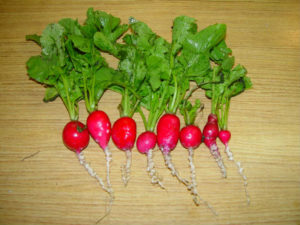
Black Root – Radishes with longer roots may develop a fungus called black root, which produces dark spots on the ends of roots. If you find this to be a reoccurring problem, you made need to grow only round radish varieties.
Aphids – These tiny sap-suckers are equal opportunity pests. They will attack just about every plant in your garden. They come in many different varieties and colors. You can learn how to identify them and how to deal with them effectively and organically in my article on aphids.
Root Maggots, also called cabbage root maggots, are the larval stage of a fly that is smaller than the traditional house fly. The flies lay their eggs in the soil near the radish. When the eggs hatch, the tiny gray-white maggots tunnel into the soil and attack the roots. You’ll know you have them if the leaves look faded, and there are grooves and tunnels in the roots.
Overly saturated soil attracts root maggots. If it has been raining a lot and the ground is wet, wait until it has dried out a bit before planting the seeds, and then be sure not to overwater. Also, you can add lime or wood ash into the soil prior to planting or as a top dressing around each plant to help deter them. Be mindful that lime and wood ash can change the pH of your soil. Crop rotation is also helpful. If you discover that you have root maggots, do not grow any other brassica in that area for a few years to break the fly-maggot cycle. You can learn more about this pest in this helpful article.
Snails and Slugs – These garden critters try to make themselves at home in just about every garden. They love to chew on the leaves and, depending on the severity, can destroy your radishes. They hide just under the surface of the soil or, if your plants are in containers, you may find them on the sides and underneath the pots. One simple method to control them involves setting an inexpensive trap. Lay a piece of board or cardboard on top of the soil. In the morning, you’ll find them taking refuge under the trap. Collect and dispose of them and reset the trap until the problem is eliminated.
Another option to control slugs and snails, and other soft-bodied insects, like cabbage worms, is to apply food-grade diatomaceous earth (DE) around the base of your plants. DE is a fine powder-like substance made from fossilized marine life. It is used routinely by countless organic gardeners. When insects move across the powder, sharp micro-fragments scrape the tissue causing them to die. For this reason, you may want to wear eye protection and avoid inhaling the powder as it could potentially harm your lungs. DE can harm bees and other pollinators, so be sure to dust your plants late in the day when they are no longer around and avoid dusting flowers. This is a brand of DE that I recommend.
Cutworms aren’t really worms; they are caterpillars (moth larvae). They are most active early in the morning or around dusk. They tend to chew the stems at the base of the plant, as well as the roots and leaves. One popular way to prevent damage is to place a cardboard collar cut from a paper towel or toilet paper tube around the base of the plant, partially submerging it under the soil.
Another way to control cutworms is to sprinkle food-grade diatomaceous earth (DE). See information under Snail and Slugs above. You can learn more about how to identify and get rid of cutworms in this article.
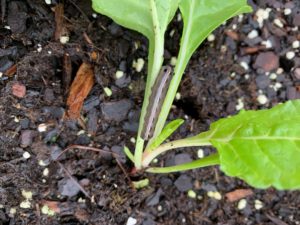
Flea Beetles – Flea beetles come in a variety of species and colors, some solid, some striped, or spotted, but the black beetle is one of the most common. You can tell it’s a flea beetle because it will jump like a flea to escape. If you find small holes in the leaves of your radishes, flea beetles or cabbage loopers (see below) should be the prime suspects.
Food-grade diatomaceous earth is a good way to deal with flea beetles (see Snails and Slugs above).
Alternatively, you can mix 2 cups of rubbing alcohol with 5 cups of water and 1 tablespoon of a chemical-free soap like Dr. Bonner’s or Dr. Wood’s. Be sure to do a test spray first and wait 24-48 hours to see if the leaf is damaged. If so, dilute the mixture more and repeat the test. Once it passes the test, spray the plant, including under the leaves. You can learn more about this garden pest in my article Flea Beetles: How to Identify and Treat Organically.
Cabbage Loopers are light green caterpillars with lateral white stripes. They propel themselves forward like an inchworm. Unfortunately, this cute caterpillar can destroy your crops in a relatively short period of time. Learn more about them and how to get rid of them organically in my article.
Harlequin Bugs – These are some of the most unique and colorful bugs in the garden. They are generally black with red, yellow, or orange markings. You may also find barrel-shaped eggs that are white and black striped on the underside of the leaves. Like other shield bugs or stink bugs, they suck the sap from plant leaves. If you notice your radish leaves are paper thin in some areas or if they have white-yellowish spots on deformed or wilting leaves, Harlequin bugs could be the culprit.
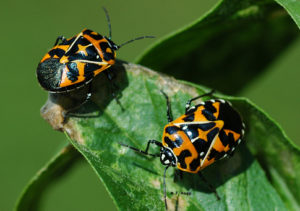
In addition to picking the bugs of the plants, a neem oil mixture will work if sprayed directly on the bugs, as will an insecticidal soap. If you don’t see the bugs, you can still spray the leaves. The solution will act as an antifeedant or an insecticide if ingested. You can make your own chemical-free sprays:
Insecticidal Soap – Mix 1 to 2 teaspoons of a chemical-free Castile soap, like Dr. Bronner’s or Dr. Wood’s, in one quart of water (or 1 tablespoon in one gallon of water). Some recipes also call for an additional surfactant such as a light oil, like avocado or olive oil, to help the spray stick to the plant’s surface and to reduce any suds or foam. Add 1-2 teaspoons per quart or 1 tablespoon per gallon. You can use a sprayer like the one I use to make application easier.
Be sure to do a spray test on a leaf and wait 24 to 48 hours to make sure the plant isn’t negatively affected. If the solution “burns” the plant, dilute the solution and try again. Once you’ve determined the solution is safe, spray all surfaces of the plant, especially the underside of leaves. Repeat every few days, or if it rains, until the problem is under control.
Neem Oil – Neem oil, which is derived from the seeds of the Indian neem tree, is effective for pests. Mix 1 to 2 teaspoons of pure, cold-pressed neem oil with the naturally occurring chemical called Azadirachtin, with 1/2 teaspoon of Castile soap like Dr. Bronner’s or Dr. Wood’s, in 1 quart of water. Be sure to do a test pray. If all goes well, spray the plant, especially under the leaves. Repeat every seven days or so or if it rains. This is the neem oil I use.
How to Harvest
Most radish varieties are ready to harvest between 21 and 25 days. Be sure to note the days to maturity listed on the seed packet so you don’t harvest them too soon or too late. If you wait too long to harvest them, the bulbs will become tough and unpleasant to eat.
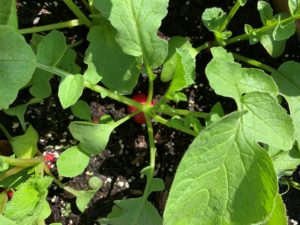
If the weather gets too warm in the spring and the radishes bolt, you can leave them in the ground and harvest the seed so that all is not lost.
After you harvest the radishes, wash off the dirt and cut the leaves and root tail off. Dry them thoroughly and store them in the refrigerator in a plastic bag or similar container. They should keep for several days. You can also wash and dry the leaves and store them like you do the radishes. They should keep for about three to five days.
Varieties
There are quite a few varieties of radishes to choose from. For example, Cherry Belle (Red Globes) is probably the most common variety and often the ones that are available in grocery stores. They are known for their bright red globes and crisp, mild peppery flavor.
Daikon radishes are white Japanese radishes that can grow quite large, up 16 inches long. They are considered a “winter radish,” which means they are starchier and spicier than red radishes. They take about 60 days to mature
French Breakfast radishes are oblong with a dark pink and white skin. They have a mild flavor and are ready to harvest in about 30 days.
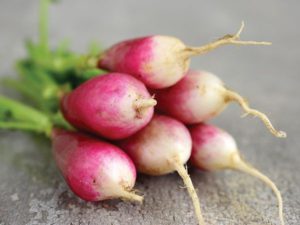
If you are looking for a sweeter radish, you can try Watermelon, which is a mild white radish with a pink center. Or the Chinese Red Meat, which is green with a pink flesh, and has a sweet but pungent flavor. Another good option would be the Purple Plum. It has dark purple skin and a cream colored flesh.
Lastly, if you want a less pungent radish, you may want to try the 6″ long White Icicle.
How to Prepare Radishes
Radishes are often used to add a bit of spice and color to a green salad, but there are other ways to prepare them as well. Long radishes are frequently used in Asian dishes or sliced and sautéed in butter with herbs. You can also roast radishes in the oven with a little olive oil and seasonings or pickle them as you would other vegetables.
If you don’t already grow radishes, consider adding them to your garden in the spring or fall. Choose more than one variety and have fun experimenting with them in a new recipe.
Thank you for reading this article! If you found it helpful, please consider sharing it via email or social media.Fckyb
